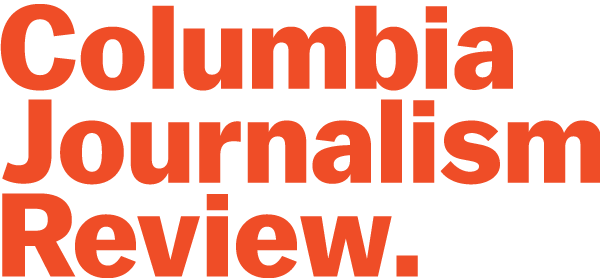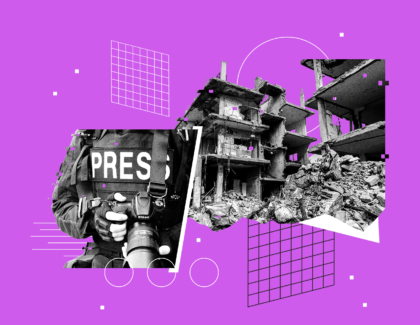Sign up for the daily CJR newsletter.
The Center for Public Integrity, a thirty-six-year-old nonprofit newsroom in Washington, DC, that won acclaim for its investigations but has endured financial and organizational turmoil for much of the past decade, has ceased publishing and is in talks to turn over its archives to the Project on Government Oversight (POGO), an anti-corruption watchdog group.
“CPI is focused on the best ways forward to honor the organization’s journalistic legacy,” the newsroom said in a statement on Monday evening. Its last major piece, “Forty Acres and a Lie,” was copublished in June of 2024 with Mother Jones and the Center for Investigative Reporting’s Reveal. The project scoured Reconstruction-era documents to tell the story of formerly enslaved people who were given land toward the end of the Civil War, only for the government to seize it back a year and a half later. The project was lauded for, among other qualities, its effective use of artificial intelligence; it won several awards.
But over the past year, CPI has essentially collapsed. In February of 2024, Paul Cheung, its chief executive, and Matt DeRienzo, its editor in chief, both left. The New York Times reported that, the previous year, the newsroom had fallen 2.5 million dollars short of its six-million-dollar budget goal. CPI explored a merger with another nonprofit newsroom, The Markup, but The Markup instead decided to join forces with CalMatters, a statewide newsroom based in Sacramento.
At the start of 2024, CPI had a staff of around twenty-five people; as of November 30, it has none. James A. Kiernan III, the longtime chair, left in June at the end of his term, along with board members George Alvarez-Correa, Bruce A. Finzen, Richard M. Lobo and Gilbert Omenn. They were not replaced. Amid the chaos of the past year, a major grant fell through, and the newsroom entered a death spiral.
For the past year, CPI’s current board chair, the investigative journalist and author Wesley J. Lowery, has effectively been overseeing the newsroom, while pursuing efforts to revive CPI or, at the least, allow its digital archive to remain available to the public. He did so while holding a full-time job leading the Investigative Reporting Workshop, which is part of American University’s School of Communications. On Monday, Lowery—one of the main editors on the “Forty Acres and a Lie” project—resigned from the CPI board, following reports in CJR and the Washington Post about Title IX complaints that had been made against him by IRW colleagues and students. Both CPI and IRW were founded by Chuck Lewis, a former 60 Minutes producer who also helped found the International Consortium of Investigative Journalists, in 1997. Lewis, who is seventy-one, now has Alzheimer’s. His friends have expressed frustration about the state of both entities under Lowery’s leadership. (Lowery declined to comment for this article.)
“As most of you all likely know, I’ve recently stepped down from my role at the IRW, and have had a wave of negative headlines (fueled, at least in part, behind the scenes, by some of our former CPI staff members),” Lowery wrote on Sunday in an email to the CPI board that CJR obtained. “I’m not expecting any additional bad press. Even so, it feels like my job here is done and with CPI’s exciting news on the horizon I want to make sure that the next chapter of CPI gets the celebration, with distance from the drama of the most recent era, that it deserves.”
Regarding the prospect of a deal with POGO, Lowery told the CPI board that “talks continue and we’ve been assured that this should be good to go by mid- to late April.” POGO has retained lawyers to “resolve their last outstanding issues,” he wrote. He had hoped that a deal could be finalized by last November, he wrote, but “I believe we’re likely at the 5-yard line, with assurances that this deal should be finalized this coming month.” Lowery added that Kate Myers—a former COO of CPI who came back to advise the newsroom in February 2024, after Cheung resigned and DeRienzo’s job was eliminated—would be working to finalize the deal.
Danielle Brian, POGO’s executive director and president, said in a statement, “I can confirm for you that POGO has been in conversations with CPI about their dissolution. But for our part, POGO has not made any decisions yet.”
The two organizations were both founded during the Reagan administration, and have long excelled at revealing government malfeasance, especially at the federal level. In accepting the archives of CPI, which won a Pulitzer Prize in 2014 for an investigation into the improper denial of health benefits to coal miners with black lung, POGO would house a rich journalistic heritage and ensure ongoing digital access to CPI’s body of work. (CPI was never a print publication; it has always collaborated with partner newsrooms.)
Cheung, who served as CPI’s CEO from 2021 to 2024, and DeRienzo, who was the editor from 2020 to 2024, clashed during their time at CPI. But in separate interviews on Monday, they were largely in agreement on the insurmountable challenges that the newsroom faced.
“CPI’s challenges reflected a broader pattern across legacy newsrooms—an attachment to practices that no longer matched the needs of the people we aimed to serve,” Cheung said. “During my tenure, we made meaningful shifts: journalists of color became the majority in the newsroom, and we built a new model of local-national partnership grounded in collaboration—not extraction.”
Cheung, a former journalist at the Associated Press and director of journalism at the Knight Foundation, added that nonprofit newsrooms “need to ask bold questions about purpose, audience, and structure.” He said that “survival requires reinvention” and that he had sought to reinvent CPI’s model so that it could train and partner with local journalists in underserved communities, in addition to pursuing traditional investigations.
Both Cheung and DeRienzo credited Susan Smith Richardson, CPI’s chief executive from 2019 to 2021, for focusing the newsroom’s attention on inequality. “We saw deeper impact from investigations, an innovative model of equitable local partnerships with local newsrooms, and some of the industry’s highest honors,” DeRienzo said in a statement. “The shift started to differentiate Public Integrity after some years of turmoil and turnover in business leadership and the challenge of competing for limited foundation and donor dollars against the likes of the much larger ProPublica and an explosion of nonprofit news outlets at the state and local level and with topical focus. ”
CPI “effectively stopped operating as a newsroom about a year ago, except for tying up loose ends with limited staffing,” DeRienzo said. “That happened soon after Wesley Lowery took over as de facto CEO from his position on the board and relationships with funders very quickly deteriorated.”
Mc Nelly Torres, a Florida-based investigative journalist who edited stories about inequality for CPI from 2021 to 2024, said that she considered both Cheung and Lowery to be poor managers, but she ultimately blamed the board for CPI’s hardships. “The board thought that because Paul had worked at the Knight Foundation that would help the organization obtain funding,” she said. “They were wrong. The same thing with Wesley: they thought that getting a celebrity reporter would bring in money. Wrong again.” CPI’s board has had no term limits—a relatively unusual circumstance, and considered a missed opportunity to enliven leadership with diverse perspectives and skills.
“It is sad that CPI is closing at a time when covering inequality in this country is more crucial than ever,” Torres said. “It is tragic, because we built one of the most diverse and talented investigative newsrooms in the United States, with journalists who loved working with each other, only for two people, who didn’t know what we were about, to destroy a newsroom that we all loved. It is enraging that the board members never learned from their mistakes and that they were such poor stewards of the organization and did not take their fiduciary duties seriously.”
The dissolution of CPI represents the end of a remarkable run. Early in its life, CPI was acclaimed for revealing the Clinton White House’s practice of inviting donors for sleepovers in the Lincoln Bedroom. Later the newsroom revealed that a subsidiary of Halliburton, the energy services giant once led by Dick Cheney, was getting a disproportionate share of no-bid government contracts in Iraq and Afghanistan while Cheney was vice president.
But by the time of the 2008 global financial crisis, when newsrooms hemorrhaged jobs, CPI was in trouble. In 2012, CJR reported that one of CPI’s top donors, the Knight Foundation, had produced a twenty-nine-page report noting industry leaders’ “apprehension” about its direction and urging CPI to diversify its funding sources, enhance its digital presence, and produce more attention-grabbing stories.
At the suggestion of John Solomon—a former editor of the conservative Washington Times who worked at CPI from 2010 to 2011, and was later associated with advancing conspiracy theories friendly to President Trump—CPI attempted to “reinvent itself as a daily destination that served up rapid-fire investigations on a variety of platforms,” CJR reported. The strategy—which evolved to include revenue from syndicated TV and radio content, a cross-platform e-reader, a premium service with an NPR-style membership program, a merger with the Huffington Post Investigative Fund, and hefty fees to Solomon’s company for ad and subscription sales—proved to be wildly unrealistic.
CPI saw a brief surge in traffic, and broke news on fast-moving scandals such as the Japanese nuclear meltdown and the bankruptcy of the solar-panel startup Solyndra. The newsroom produced an award-winning series about the black market for bluefin tuna. Even so, “the organization never managed to get out anywhere close to ten stories a day, and many of the quick-turnaround pieces it did produce were closer to standard daily fare than genuine investigations,” CJR found. Eventually, traffic plunged. CPI laid off a third of its staff.
Around the same time, ProPublica, founded in 2008, was emerging as the nation’s most important investigative newsroom, and other nonprofit outlets sprouted across the country. That placed challenges on CPI, founded in 1989, as each organization competed for scarce resources. Cheung said that ProPublica and Reveal had “raised expectations for what nonprofit investigative journalism could achieve.” America needs multiple nonprofit newsrooms: “This space isn’t zero-sum,” he said. “Multiple models can succeed together. Change requires vision, alignment, and willingness to let go of old habits. In legacy institutions like CPI, that can feel threatening—and that fear can slow necessary shifts.”
Richard J. Tofel—the former general manager and then president of ProPublica, where he worked from 2007 to 2021—analyzed CPI’s challenges in a recent post on his Substack. He noted “the very considerable turnover at the top of the organization, and, relatedly I think, the long-term, cultural shortcomings of its Board of Directors.” Examining spending from 2006 to 2022 (both in absolute and inflation-adjusted dollars), Tofel found only one three-year period of prolonged growth (2007 to 2010) and nine years of contraction. And yet over the past twenty years, more than a hundred and fifty million dollars in charitable giving had been spent at CPI.
Lowery, who became cochair in 2023 and then sole chair after Kiernan stepped down last June, noted in his email to CPI’s board that he joined in 2021 at the invitation of Smith Richardson “only for her to quickly depart.” He added that he “was here for the Paul era, and as you all know first stepped into board leadership as a last-ditch effort for us to try to calm the civil war that engulfed the organization these last few years.”
“My three-month board co-chair appointment ultimately stretched on for a year and a half, during which I’m proud we were able to ensure all of our staff got severance, all of our obligations to our funders were met, and we landed the ‘40 Acres’ project,” he continued. “As you all know, none of those were givens, and few will appreciate how close each of those things came to not happening.”
In hindsight, the Times article from last February, which revealed that CPI was weighing a merger or shutdown, helped doom CPI by scaring off potential rescuers. Two days after the story was published, CPI gave the journalists’ union notice of major layoffs. Soon after, Arnold Ventures—the philanthropic arm of the Houston couple John and Laura Arnold—rescinded what would have been the second half of a two-year, million-dollar grant. Then CPI was forced to lay off practically its entire staff to cover severance payments. The newsroom scrambled for funding to extend the stay of a few journalists, including those needed to complete the “Forty Acres and a Lie” project. Out of options, CPI began talks with POGO.
Editor’s Note: This article has been updated.
Has America ever needed a media defender more than now? Help us by joining CJR today.







